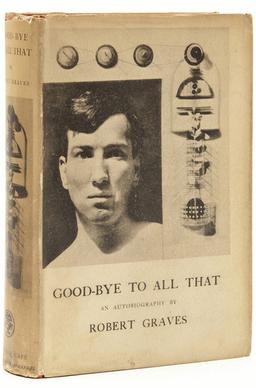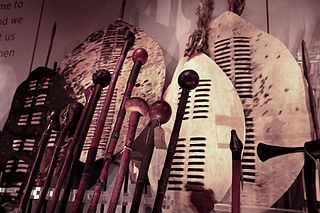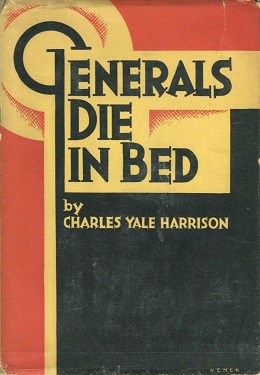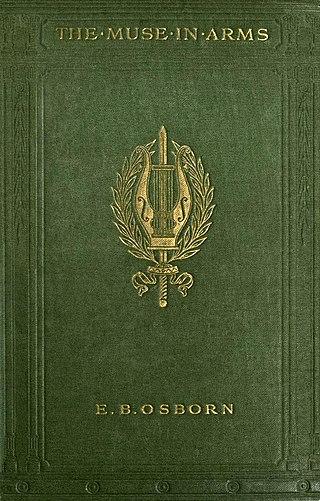
Captain Robert von Ranke Graves was an English poet, historical novelist and critic. His father was Alfred Perceval Graves, a celebrated Irish poet and figure in the Gaelic revival; they were both Celticists and students of Irish mythology. Graves produced more than 140 works in his lifetime. His poems, his translations and innovative analysis of the Greek myths, his memoir of his early life—including his role in World War I—Good-Bye to All That (1929), and his speculative study of poetic inspiration The White Goddess have never been out of print. He is also a renowned short story writer, with stories such as "The Tenement" still being popular today.

Good-Bye to All That is an autobiography by Robert Graves which first appeared in 1929, when the author was 34 years old. "It was my bitter leave-taking of England," he wrote in a prologue to the revised second edition of 1957, "where I had recently broken a good many conventions". The title may also point to the passing of an old order following the cataclysm of the First World War; the supposed inadequacies of patriotism, the interest of some in atheism, feminism, socialism and pacifism, the changes to traditional married life, and not least the emergence of new styles of literary expression, are all treated in the work, bearing as they did directly on Graves's life. The unsentimental and frequently comic treatment of the banalities and intensities of the life of a British army officer in the First World War gave Graves fame, notoriety and financial security, but the book's subject is also his family history, childhood, schooling and, immediately following the war, early married life; all phases bearing witness to the "particular mode of living and thinking" that constitute a poetic sensibility.

Siegfried Loraine Sassoon was an English war poet, writer, and soldier. Decorated for bravery on the Western Front, he became one of the leading poets of the First World War. His poetry both described the horrors of the trenches and satirized the patriotic pretensions of those who, in Sassoon's view, were responsible for a jingoism-fuelled war. Sassoon became a focal point for dissent within the armed forces when he made a lone protest against the continuation of the war with his "Soldier's Declaration" of July 1917, which resulted in his being sent to the Craiglockhart War Hospital. During this period he met and formed a friendship with Wilfred Owen, who was greatly influenced by him. Sassoon later won acclaim for his prose work, notably his three-volume, fictionalised autobiography, collectively known as the Sherston trilogy.

Wilfred Edward Salter Owen MC was an English poet and soldier. He was one of the leading poets of the First World War. His war poetry on the horrors of trenches and gas warfare was much influenced by his mentor Siegfried Sassoon and stood in contrast to the public perception of war at the time and to the confidently patriotic verse written by earlier war poets such as Rupert Brooke. Among his best-known works – most of which were published posthumously – are "Dulce et Decorum est", "Insensibility", "Anthem for Doomed Youth", "Futility", "Spring Offensive" and "Strange Meeting". Owen was killed in action on 4 November 1918, a week before the war's end, at the age of 25.

Edmund Charles Blunden was an English poet, author, and critic. Like his friend Siegfried Sassoon, he wrote of his experiences in World War I in both verse and prose. For most of his career, Blunden was also a reviewer for English publications and an academic in Tokyo and later Hong Kong. He ended his career as Professor of Poetry at the University of Oxford. He was nominated for the Nobel Prize in Literature six times.

Memoirs of a Fox-Hunting Man is a novel by Siegfried Sassoon, first published in 1928 by Faber and Faber. It won both the Hawthornden Prize and the James Tait Black Memorial Prize, being immediately recognised as a classic of English literature. In the years since its first appearance, it has regularly been a set text for British schoolchildren.

Regeneration is a historical and anti-war novel by Pat Barker, first published in 1991. The novel was a Booker Prize nominee and was described by the New York Times Book Review as one of the four best novels of the year in its year of publication. It is the first of three novels in the Regeneration Trilogy of novels on the First World War, the other two being The Eye in the Door and The Ghost Road, which won the Booker Prize in 1995. The novel was adapted into a film by the same name in 1997 by Scottish film director Gillies MacKinnon and starring Jonathan Pryce as Rivers, James Wilby as Sassoon and Jonny Lee Miller as Prior. The film was successful in the UK and Canada, receiving nominations for a number of awards.

Literature about World War I is generally thought to include poems, novels and drama; diaries, letters, and memoirs are often included in this category as well. Although the canon continues to be challenged, the texts most frequently taught in schools and universities are lyrics by Siegfried Sassoon and Wilfred Owen; poems by Ivor Gurney, Edward Thomas, Charles Sorley, David Jones and Isaac Rosenberg are also widely anthologized. Many of the works during and about the war were written by men because of the war's intense demand on the young men of that generation; however, a number of women created literature about the war, often observing the effects of the war on soldiers, domestic spaces, and the home front more generally.
The Sherston trilogy is a series of books by the English poet and novelist, Siegfried Sassoon, consisting of Memoirs of a Fox-Hunting Man, Memoirs of an Infantry Officer, and Sherston's Progress. They are named after the protagonist, George Sherston - a young Englishman of the upper middle-class, living immediately before and during the First World War.

Craiglockhart Hydropathic, now a part of Edinburgh Napier University and known as Craiglockhart Campus, is a building with surrounding grounds in Craiglockhart, Edinburgh, Scotland. As part of a large extension programme by the university in the early 2000s the original building and surrounding campus underwent significant restoration and modernisation as a result many of the original interior features of the building are no longer visible. The exterior of the building has been preserved.
Vivian de Sola Pinto was a British poet, literary critic and historian. He was a leading scholarly authority on D. H. Lawrence, and appeared for the defence in the 1960 Lady Chatterley's Lover trial.
"Suicide in the Trenches" is one of the many poems the English poet Siegfried Sassoon (1886–1967) composed in response to World War I, reflecting his own notable service in that especially bloody conflict. Sassoon was a brave and gallant upper-class officer who eventually opposed the war, but he never lost his admiration for the common soldiers who had to fight it. Sassoon felt contempt for the political leaders and civilian war hawks who, safe in their power and comfort, sent young men off to die in huge battles that seemed futile and pointless. It was first published 23 February 1918 in Cambridge Magazine, then in Sassoon's collection: Counter-Attack and Other Poems. The poem is written in iambic tetrameter and consists of twelve lines in three stanzas.

A knobkerrie, also spelled knobkerry, knobkierie, and knopkierie (Afrikaans), is a form of wooden club, used mainly in Southern and Eastern Africa. Typically they have a large knob at one end and can be used for throwing at animals in hunting or for clubbing an enemy's head. For the various peoples who use them, they often have marked cultural significance. Being able to carry the knobkerrie has also had a political dimension, especially in South Africa.

Generals Die in Bed is an anti-war novella by the Canadian writer Charles Yale Harrison. Based on the author's own experiences in combat, it tells the story of a young soldier fighting in the trenches of World War I. It was first published in 1930 by William Morrow.

Under Fire: The Story of a Squad by Henri Barbusse, was one of the first novels about World War I to be published. Although it is fiction, the novel was based on Barbusse's experiences as a French soldier on the Western Front. It was awarded the Prix Goncourt in 1916.
The Secret Battle is a novel by A. P. Herbert, first published in 1919. The book draws upon Herbert's experiences as a junior infantry officer in the First World War, and has been praised for its accurate and truthful portrayal of the mental effects of the war on the participants. It was one of the earliest novels to contain a detailed description of Gallipoli, and to challenge the Army's executions of soldiers for desertion. It is noticeable as being sharply different from Herbert's later work—there is no note of humour or lightness in the novel, simply a stark and simple narrative.

Sherston's Progress is the final book of Siegfried Sassoon's semi-autobiographical trilogy. It is preceded by Memoirs of a Fox-Hunting Man and Memoirs of an Infantry Officer.

The Muse in Arms is an anthology of British war poetry published in November 1917 during World War I. It consists of 131 poems by 52 contributors, with the poems divided into fourteen thematic sections. The poets were from all three branches of the armed services, land, sea and air, from a range of ranks and from many parts of the UK. Twenty of the poets who contributed to this volume died during the war. The editor was the journalist and author Edward Bolland Osborn (1867–1938), and the book was printed in London by the publishers John Murray. This anthology was one of several collections of war poetry published in the UK during the war. It "achieved large sales", and was reprinted in February 1918. It has been referenced in several analyses of First World War poetry and has been described as "the most celebrated collection of the war years".
Second Lieutenant David Cuthbert Thomas was a Welsh soldier of the British Army who served during the First World War. He is best known for his association with the poet Siegfried Sassoon, who after his death became the subject of some of the greatest war poems by Sassoon and Robert Graves.

John Bernard Pye Adams was a British army officer during World War I and a writer. His book of memoirs, Nothing of Importance, was the first published book about life in the trenches, and the only one published before the end of the war. Adams did not live to see its publication, dying in France of wounds suffered while leading an attack in February 1917.















